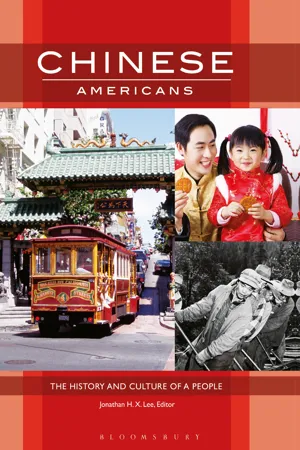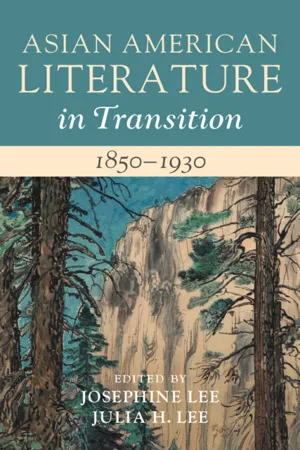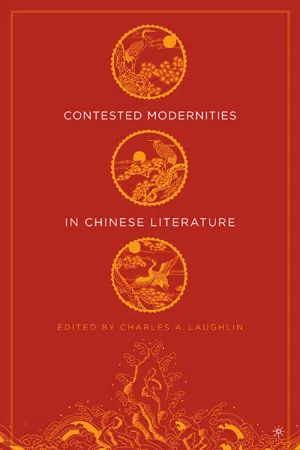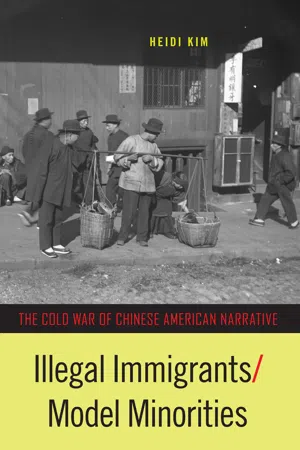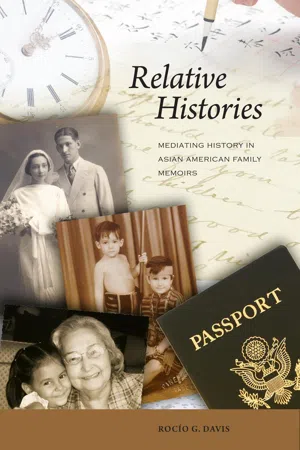Literature
Chinese American Literature
Chinese American literature encompasses literary works written by Chinese Americans, exploring themes of identity, immigration, and cultural assimilation. It reflects the experiences and perspectives of Chinese immigrants and their descendants in the United States, often addressing issues of discrimination, family dynamics, and the search for belonging. This body of literature contributes to a diverse and rich tapestry of American literary expression.
Written by Perlego with AI-assistance
Related key terms
1 of 5
7 Key excerpts on "Chinese American Literature"
- eBook - ePub
Chinese Americans
The History and Culture of a People
- Jonathan H. X. Lee(Author)
- 2015(Publication Date)
- ABC-CLIO(Publisher)
The Joy Luck Club was embraced by the American literary community and was made into a major Hollywood motion picture in 1993 with a largely Asian cast. Tan’s success signaled a shift in Chinese American publishing because Tan was heralded as a writer with more universal themes than her predecessors. In a sense, Tan’s success also ushered in a new era for Chinese American writing, which is more diverse than in the past and covers a wide range of themes, aesthetics, and concerns.Several Chinese American writers have received success throughout the 1990s to today. Among them are David Wong Louie’s (1954–) short stories, Pangs of Love (1991); Eric Liu’s (1968–) collected memoirs and essays in The Accidental Asian: Notes of a Native Speaker (1997); Gish Jen’s (1955–) Tiger Writing: Art, Culture, and the Interdependent Self (2013); Jean Kwok’s Girl in Translation (2010) and Mambo in Chinatown (2014); and Shirley Geok-lin Lim’s (1944–) collection of poems, Crossing The Peninsula (1980). Writing for young adults, Laurence M. Yep (1948–) has published 10 Golden Mountain Chronicles that spans the period of 1835 to the present, four Dragon fantasies, three Chinatown mysteries, and much more. Gene Luen Yang (1973–) published the graphic novel, American Born Chinese (2008), which employs the popular Chinese Buddhist folklore of the Monkey King and the relationship between an American-born Chinese American and a Taiwan-born Chinese classmate. Central to all these works is the issue of identity across cultural landscapes and time.Although early Chinese American Literature was primarily set in Chinatown, the cultural tussles of being both Chinese and American continue to be a muse for current writers and, by extension, future writers. The expressions of identities will continue to be a universal theme that resonates with other immigrants and reflects an archetypical life experience of being an immigrant in America, which for Chinese Americans is the multiple dimensions and expressions of self, community, and history through writing.See also: Angel Island Immigration Station; Folklore in Children’s LiteratureFurther Reading
Chang, Joan Chiung-Heui. 2000. Transforming Chinese American Literature: A Study of History, Sexuality, and Ethnicity - eBook - PDF
Books and Beyond
The Greenwood Encyclopedia of New American Reading [4 volumes]
- Kenneth Womack(Author)
- 2008(Publication Date)
- Greenwood(Publisher)
Subjectivities in writings by the latter camp of Asian American writers, thus, “are forged upon numerous interstices involving variables such as economic and social status, reli- gious affiliation, physical ability, gender and sexuality, degree of linguistic compe- tence, and acceptance and integration into Western capitalist and consumer culture” (Ty and Goellnicht 2004, 5). The development of a diverse, heterogeneous Asian American literature that fea- tures a great variety of genres, themes, and styles, enacts both a continuation of and a departure from previous Asian American literature. Context and Issues. Since the 1980s, “Asian American writers have been extremely productive,” and all types of their writings, such as novels, poems, sto- ries, plays, memoirs, and autobiographies have drawn attention from and been pub- lished by mainstream presses, “often garnering national awards and international recognition” (Lim and Ling 1992, 3). The rapid growth and wide recognition of Asian American literary production in the last quarter of the twentieth century through the cusp of the twenty-first century, have not only made the voice of Asian American literature heard loud and clear but have also helped break the conven- tional thematic, generic boundaries of this literature. As Maxine Hong Kingston once hoped (Rabinowitz 1987, 182), Asian American writing is now, like its earlier 76 ASIAN AMERICAN LITERATURE African and Native American counterparts, assuming an undisputable and undeni- able position in contemporary American literature. The coming-of-age of Asian American literature flourishes in response to changing patterns of Asian immigration. In reality, the Asian groups embraced by the rubric “Asian America” encompass not a static list but a dynamic collection of immigrant communities. According to some census statistics, the Chinese American community is the largest, which also includes the largest percentage of American-born members. - Josephine Lee, Julia H. Lee(Authors)
- 2021(Publication Date)
- Cambridge University Press(Publisher)
early Asian North American literature represented a diversity of forms and themes – a Cambrian explosion of subjectivities, identities, performances, and forms – these studies wrestle with how best to frame and interpret these myriad texts, the complicated conditions under which different works were produced, and how these works continue to have representa- tional force in the present. The Chapters Despite the enormous challenges that Asians living in the United States and Canada faced, they were still able to produce literary and cultural works, both in English and in their native languages, that explored their place within an increasingly multiracial and multiethnic nation and chal- lenged the marginalization and exclusion that was often their lot. While the amount of writing produced by Asian North Americans in the nineteenth and early twentieth century may seem relatively small, one should not underestimate its importance in understanding Asian North American literature as a whole. In the case of the United States, literary and cultural texts set the terms for later critiques of US nation and imperialism, help in identifying and grappling with the gendering and racializing projects of US racist discourse (so important to post-1965 Asian American literature), and help us question the viability of the very notion of “Asian America.” This literary and cultural production also marked how social, political, and economic relationships with Asia – whether literal or imagined – were formative to the construction of nineteenth-century and modern national identities. Asians in North America were affected not only by the laws and ideologies of exclusion, but also by a long history of European and American orientalism that fantasized about the Asian racial “other” in diverse and complex ways. Thus early literature and culture reveals the active negotiation of the practice of labor and commodification in which Asian North Americans were engaged.- eBook - PDF
- C. Laughlin(Author)
- 2005(Publication Date)
- Palgrave Macmillan(Publisher)
Despite the title, this chapter actually does not ask the question of “in what ways is this Anglophone literature Chinese.” Instead, I ask, “in what ways is it not Chinese?” Ultimately, I suggest that the Chineseness of the particular authors examined here lies not so much in their Chinese ancestry, as in their active engagement with the question of what it means to be Chinese outside of China. Crafting a Chinese American Vernacular In Asian American literary studies, which emerged in the late 1960s and early 1970s, language has always been a key issue. The first MLA bibliography of Asian American literature defined it as literature written in English by authors of Asian descent living in America. 13 The English-language basis of the field has been important to an area of study that explicitly defined itself as paneth- nic, encompassing writers of diverse Asian ancestry. Although recent scholar- ship has done much to bring Asian-language writing into the fold, this is predominantly how the canon has been defined until this time. 14 Despite the fact that Anglophone writing has been the mainstream of Asian American literature, or Chinese American Literature more specifically, bilingualism, translation, and the problematics of language have been central issues in the field. Most Chinese American Literature makes use of some form of bilingualism, whether through code switching, pidgin, translations of Chinese phrases, or imaginary Chinese dialogue rendered in English. In addition, bilingualism early on emerged as a central trope of Chinese American Literature. In one early model, bilingualism was conceptualized as a split between the mother tongue and the language of the dominant society. Writers thus employed bilingualism as a trope to talk about cultural and generational conflicts. - eBook - ePub
- C. T. Hsia(Author)
- 2004(Publication Date)
- Columbia University Press(Publisher)
The essay, therefore, is mainly concerned with the so-called traditional or classical literature recorded in Chinese since pre-Confucian times and expressive in the main of the dominant Chinese culture in the service of a despotic government supposedly Confucian in character. This is an indigenous literature cast in distinctly Chinese forms or genres and composed mainly by scholars primarily trained for government service. These writers, of course, were not cut off from popular music and oral entertainment, and in the later dynasties a great number wrote drama and fiction largely or mainly in the vernacular, almost in defiance of their training as poets and prose writers in classical Chinese. Except for folk songs and some forms of oral entertainment, the contribution of the people as such to the making of this literature is of little importance. What was once foreign in terminology and ideology (Buddhism, predominantly) has long been part of the Chinese tradition, so the issue of foreignness does not arise in the reading of this literature. As for the more modern western influence brought to court by such Jesuit missionaries as Matteo Ricci (1552–1610), it is so little reflected in the literature of the seventeenth and eighteenth centuries that we are justified in identifying the modern period solely with the twentieth century.Before we can study the reception abroad of classical Chinese literature today, we must, of course, gauge the health and vitality of that literature as it appears to the Chinese themselves, on the mainland and in Taiwan. It would be unlikely that a body of literature to which the Chinese have become indifferent could become much read in translation by foreigners. Historically, the key importance of that literature to the intellectual training and spiritual sustenance of Chinese scholar-officials, and therefore to the maintenance of Chinese culture and political order, was never in question. It could never be in question either that serious students of Chinese culture and history should read at least the acknowledged masterpieces of that literature, in translation if not in the original, irrespective of its intrinsic worth as literature and of the size of its audience among the Chinese themselves. But, of course, even the intrinsic worth of Shakespeare depends upon the continuing training of the young to appreciate his works and their willing subjection to the necessary rigors of that training. His intrinsic worth has no practical meaning if the younger generation everywhere suddenly turns a deaf ear to his poetry. If this indifference were to continue for a few decades, it is conceivable that the educators concerned would revise the curriculum and displace Shakespeare with writers more congenial to the students. Thus it is entirely possible that someday even serious students of sinology would take only a token interest in classical literature. - eBook - PDF
Illegal Immigrants/Model Minorities
The Cold War of Chinese American Narrative
- Heidi Kim(Author)
- 2021(Publication Date)
- Temple University Press(Publisher)
However, a great History, through Literature / 141 shift in the late 1960s and 1970s was the Asian American movement, which paired a cross-racial, cross-ethnic solidarity in addressing domestic civil rights issues with a sense of global solidarity with those affected by U.S. imperialism, particularly focusing on the Vietnam War. Chinese American authors could thus appeal to an invigorated audience that they had not pre-viously been able to rely on, framing themselves within a larger and more visible political identity. 4 The landscape of U.S. relations with mainland China was also rapidly shifting for the better, which relieved some of the negative perceptions through which Chinese Americans had suffered during the Confession era and made it easier for authors who had embraced the proto-model minority image to now voice critiques and hard truths. The so-called ping pong di-plomacy of the U.S. men’s table tennis team’s trip to China in 1971 paved the way for President Richard Nixon’s weeklong visit to China in 1972, which ended the quarter-century of diplomatic estrangement between the two na-tions. The strong media coverage of Nixon’s trip ensured positive reactions back in the United States. By the end of the decade, the United States and China had once again established formal diplomatic relations. Peter Kwong describes this as leading to a halcyon time, when Chinese Americans were viewed with less suspicion before economic competition and renewed scru-tiny of Communist China in the 1990s. 5 In this new climate, with a larger, more diverse, and more politically ac-tive community, as well as a more favorable mainstream climate, Chinese American writers neither embraced a utopian future nor joyfully shed the fears and stigma of the past. - eBook - PDF
Relative Histories
Mediating History in Asian American Family Memoirs
- Rocio G. Davis(Author)
- 2010(Publication Date)
- University of Hawaii Press(Publisher)
Family memoirs that focus on Chinatown tease out deep repercussions regarding larger issues of self-representation within Asian American identity politics. Sau-Ling Wong argues that in texts with interventional ambitions, such as these auto/biographical texts, “Chinatown becomes a particularly con-tested territory, for the same reality found within its boundaries may be coded The Chinese in America 103 in vastly divergent ways depending on who is looking and who is speaking. How Chinatown is represented in a writer’s work is often regarded as a touch-stone of his/her artistic credibility. This is especially true of the American-born Anglophone writers of Chinese ancestry for whom the American scene is the sole arena for their creative energies and being ethnic is not a matter of choice” (“Ethnic Subject” 252). The word “Chinatown” itself is laden with sociohis-toric connotations, and a realm of complex, dynamic valences lies beyond the name. As Sau-ling Wong explains, to a sizeable portion of the Chinese population of any given large American city, Chinatown means habitation, permanent home, a locus of familiarity, security, and nurturance, while to the tourists in quest of exciting but ultimately safe cultural encounters, however, Chinatown provided spectacle, a diverting, exotic sideshow (253). 6 Jeffrey Partridge makes a useful proposal that links the existence of Chi-natown with the development and reception of Chinese American Literature: “The relationship is on the one hand metaphoric because the dynamics that produce what I am calling the ‘literary Chinatown’ are like those that pro-duced the historic American Chinatowns. That is, what readers reading from a Euro-American perspective assume about, and expect of, Chinese American Literature has to a large extent shaped it as a virtual version of the Ameri-can Chinatown.
Index pages curate the most relevant extracts from our library of academic textbooks. They’ve been created using an in-house natural language model (NLM), each adding context and meaning to key research topics.
